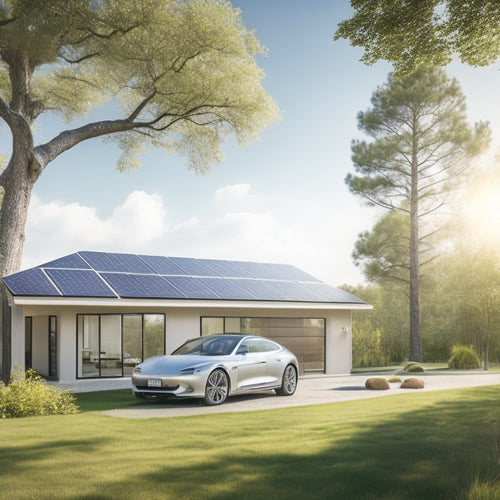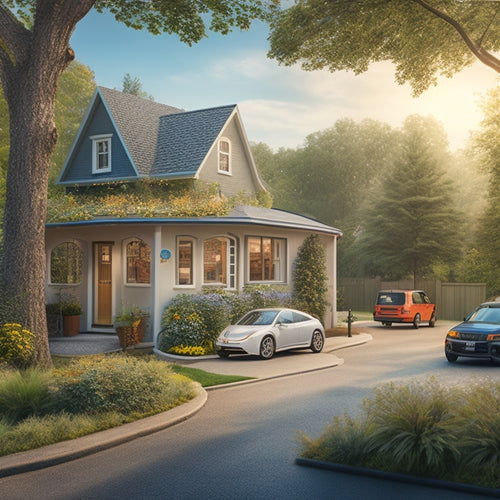
Solar Panels Built Into Roofs: Pros and Cons
Share
You're considering integrating solar panels into your roof, which can provide energy independence, sustainability, and a lifespan of 25 years or more. The streamlined appearance enhances your roof's visual appeal, and customization options allow you to match your roof's color, texture, and style. However, integration poses structural integrity concerns, installation complexity issues, and higher upfront costs. Energy output varies depending on panel angle, orientation, and shading, and maintenance requirements include routine checks and cleaning. As you weigh the pros and cons, you'll want to investigate these factors in more detail to determine if built-in solar panels are right for your home.
Key Takeaways
- Built-in solar panels offer energy independence, sustainability, and a typical lifespan of 25 years or more, making them a long-term energy solution.
- They provide a streamlined appearance, customization options, and increased curb appeal, enhancing the overall aesthetic of a home.
- However, integration into the roof structure requires careful consideration of structural integrity, weather resistance, and material durability.
- Higher upfront costs and installation complexity are significant drawbacks, although long-term savings and financing options can help offset these expenses.
- Regular maintenance is necessary to ensure optimal energy output, involving routine checks, cleaning, and inspections to prevent electrical faults and water damage.
Built-In Solar Panel Advantages
As you consider integrating solar panels into your roofing system, it's essential to understand the advantages of built-in solar panels. One significant benefit is that they provide energy independence, allowing you to generate your own clean energy and reduce your reliance on the grid.
This not only saves you money on your utility bills but also contributes to a more sustainable living environment. Built-in solar panels are designed to last, with a typical lifespan of 25 years or more, making them a long-term solution for your energy needs.
They're also more efficient than traditional solar panels, as they're integrated into the roofing system, eliminating the need for additional mounting structures. This streamlined design also reduces wind resistance and noise, making them a more practical choice.
Aesthetics and Design Benefits
Your roof is more than just a protective barrier; it's a visual statement that reflects your personal style.
With built-in solar panels, you can enhance your home's visual appeal while generating clean energy. These sleek, modern designs offer a seamless integration of form and function.
Here are some benefits of built-in solar panels:
-
Streamlined appearance: Built-in solar panels eliminate the need for bulky mounting systems, creating a clean, streamlined look that complements your roof's design.
-
Customization options: Built-in solar panels can be designed to match your roof's color, texture, and style, providing unparalleled design flexibility.
-
Increased curb appeal: A built-in solar panel system can increase your home's value and appeal, making it more attractive to potential buyers if you decide to sell in the future.
- Design freedom: With built-in solar panels, designers and planners have more freedom to create innovative, energy-efficient designs that meet your unique needs and style.
Roof Integration Challenges
When you integrate solar panels into a roof, you'll face structural integrity concerns, as the added weight and stress can compromise the roof's ability to withstand environmental factors like wind and rain.
You'll also encounter installation complexity issues, as the panels must be precisely fitted and connected to guarantee peak energy generation.
These challenges require careful consideration to guarantee a safe and efficient installation.
Structural Integrity Concerns
The roof's structural integrity is a critical consideration when integrating solar panels into its design.
You'll need to verify that your roof can support the added weight of the solar panels, as well as withstand various environmental factors.
When evaluating the structural integrity of your roof, consider the following key factors:
-
Load bearing capacity: Can your roof support the weight of the solar panels, as well as snow, wind, and other external forces?
-
Weather resistance: Will the solar panels and roofing materials withstand harsh weather conditions, such as heavy rain, hail, and extreme temperatures?
-
Material durability: Are the materials used in the solar panels and roofing system durable enough to last for decades, with minimal maintenance and repairs?
- Insulation properties: How will the solar panels affect the roof's insulation properties, and will they compromise the energy efficiency of your home?
Installation Complexity Issues
Solar panel roof integration presents a unique set of installation difficulty issues that can make or break the success of your project.
You'll need to take into account the various installation techniques required for built-in solar panels, which can be more complicated than traditional solar panel installations. For instance, you'll need to confirm that the solar panels are properly sealed to prevent water ingress, and that the roofing material is compatible with the solar panels.
Weather considerations also play a critical role in installation difficulty. You'll need to account for wind loads, hail, and snow loads, which can affect the structural integrity of the roof. Additionally, you'll need to verify that the solar panels are installed at an ideal angle to maximize energy production, while also assessing the roof's drainage system to prevent water accumulation.
To overcome these challenges, it's important to work with experienced installers who've a thorough knowledge of roofing and solar panel installations. They can help you traverse the intricacies and confirm a successful integration that meets your energy needs.
Cost and Efficiency Concerns
When you consider integrating solar panels into your roof, you'll need to weigh the benefits against the higher upfront costs, which can be a significant barrier to adoption.
You'll also need to account for the variance in energy output, as the panels' performance can be affected by factors like roof orientation, shading, and climate.
As you assess the viability of built-in solar panels, it's crucial to understand these cost and efficiency concerns to make an informed decision.
Higher Upfront Costs
Opting for solar panels built into roofs means facing higher upfront costs, which can be a significant deterrent for many homeowners. The integrated design and advanced technology come at a price, making it crucial to evaluate the costs against the benefits.
Here are some key factors contributing to the higher upfront costs:
-
Customization: Built-in solar panels require a customized design and installation, increasing the initial investment.
-
Advanced materials: The integrated panels use high-quality, durable materials that are more expensive than traditional solar panels.
-
Labor costs: The installation process is more complex and time-consuming, leading to higher labor costs.
- Certification and testing: Built-in solar panels must meet specific building codes and undergo rigorous testing, adding to the upfront costs.
While the initial investment may seem overwhelming, it's important to reflect on the long-term savings and financing options available.
Many homeowners find that the benefits of built-in solar panels, including increased energy independence and potential long-term savings, outweigh the higher upfront costs.
Energy Output Variance
Reliability is key when it comes to utilizing renewable energy from the sun. As you consider integrating solar panels into your roof, it's vital to understand the energy output variance.
You'll find that energy production factors, such as panel angle, orientation, and shading, greatly impact your system's performance. Weather conditions, like cloud cover, temperature, and humidity, also influence energy output.
You should expect a decrease in energy production during winter months due to shorter days and lower sun angles. Conversely, you'll see an increase in energy output during summer months when the sun is higher in the sky.
Additionally, weather events like hurricanes or dust storms can reduce energy production. It's important to assess your location's specific weather patterns and adjust your system design accordingly.
Installation and Maintenance Needs
Getting solar panels built into your roof requires careful planning and execution to guarantee a seamless integration with your existing roofing system.
You'll need to take into account factors like your roof's size, shape, and material, as well as local building codes and regulations.
When it comes to installation, you'll want to make sure that your chosen installation techniques are compatible with your roof's specific needs.
This may involve:
- Assessing your roof's structural integrity to make certain it can support the added weight of the solar panels.
- Removing existing roofing materials to make way for the solar panels, which can be a time-consuming process.
- Installing flashing and weatherproofing to prevent water damage and maintain a watertight seal.
- Connecting the solar panels to your electrical system, which requires specialized knowledge and equipment.
In terms of maintenance frequency, you can expect to perform routine checks and cleaning every 6-12 months to guarantee peak energy output.
Regular maintenance can help prevent issues like debris buildup, electrical faults, and water damage.
Future of Roof-Integrated Solar
As the solar industry continues to evolve, roof-integrated solar panels are positioned to play an increasingly prominent role in the shift towards renewable energy. You can expect to see significant improvements in their design, functionality, and affordability in the coming years.
| Trend | Impact on Roof-Integrated Solar |
|---|---|
| Technological advancements | Increased efficiency, thinner profiles, and more durable materials |
| Decreasing costs | Wider adoption, increased market share, and reduced installation costs |
| Government incentives | Accelerated growth, increased investment, and policy-driven innovation |
As you consider incorporating roof-integrated solar panels into your home or business, you'll want to keep an eye on market trends and technological advancements. With the industry moving towards more efficient and affordable solutions, you can expect to see wider adoption and increased investment in roof-integrated solar technology. This shift will not only benefit the environment but also provide you with a reliable source of renewable energy and a potential increase in your property's value.
Frequently Asked Questions
Can I Install Built-In Solar Panels on an Existing Roof?
You're wondering if you can install built-in solar panels on your existing roof. Take, for instance, a homeowner in California who retrofitted their 10-year-old roof with integrated solar tiles, blending seamlessly with the original design. You'll need to assess your roof's condition and follow a specialized installation process to reap the aesthetic benefits.
Are Roof-Integrated Solar Panels Compatible With All Roof Types?
You'll find that roof-integrated solar panels aren't compatible with all roof types, as installation challenges arise with complex or fragile roofs, such as slate or clay tiles, which require specialized installation techniques and equipment.
Will Built-In Solar Panels Affect My Home's Resale Value?
You'll be interested to know that 83% of homebuyers consider energy efficiency a top priority. By investing in built-in solar panels, you'll enhance your home's resale value with a desirable solar investment, as it raises your property's energy efficiency and appeal to eco-conscious buyers.
Can I Claim Tax Credits for Roof-Integrated Solar Panels?
You can claim tax credits for roof-integrated solar panels, which can greatly offset installation costs. The IRS offers a 26% tax credit on eligible expenses, providing substantial tax benefits that'll help power your savings.
Do Built-In Solar Panels Require Special Permits or Licenses?
You'll need to maneuver through local building codes, installation regulations, and permit costs to determine if special permits or licenses are required for built-in solar panels, as local ordinances vary, and compliance is essential for a successful installation.
Related Posts
-

Why Invest in Solar Car Battery Chargers Online?
By investing in a solar car battery charger online, you're not only reducing your reliance on fossil fuels but also o...
-

Why Nearby EV Conversion Shops Matter to You
Having a nearby EV conversion shop means you'll experience the benefits of a more personalized, convenient, and susta...
-

What Role Do Unicycles Play in Urban Transport?
As you navigate through congested city streets, unicycles emerge as a viable solution, slashing carbon emissions by u...


